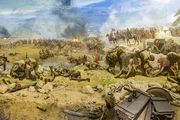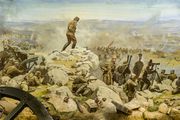Panoramas and Paints
In the second part of the Museum of ATATÜRK and Independence War, three panoramas displaying Gallipoli Campaign, Sakarya Pitched Battle and the Great Offensive attract attention. Those large panoramas were given a three dimensional effect with an area arranged in front. Here, the difficulties experienced on the way to Independence and the foundation of the new Turkish Republic are animated for the visitors.
There are also portraits of Mustafa Kemal ATATÜRK and some commanders fought in the War of Independence and other oil paintings displaying various moments of the War of Independence in this section.
The works in this section were made with the joint efforts of Turkish, Azerbaijani and Russian artists.
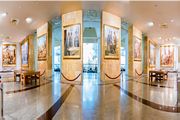
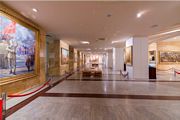
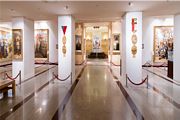
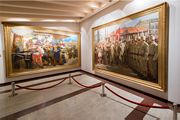
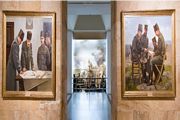
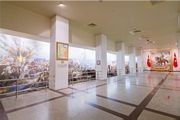

The first panorama in this section gives information about the Sea and Land Battles in Gallipoli. The panorama has been given a striking effect with three dimensional animations and sound effects. During the World War I, Britain and France aimed to sweep the Ottoman State out of the war by seizing Istanbul to provide help for Russia. For this purpose, they opened the Gallipoli Front. The allied nations established the largest navy in the world with more than 400 ships. They entered into Dardanelles Strait with armored ships and cruisers on March 18, 1915. After the battles lasting 7-8 hours, three warships and three torpedo boats were sunk by the Turkish bastions and three ships were seriously damaged. The Entente Powers seeing that they wouldn’t pass through Bosporus launched land wars by deploying troops in five critical areas of Gelibolu Peninsula on April 25, 1915. The landing unions consist of England and its colonies which are Australia, New Zealand and Ireland, troops brought from India and French troops.
During the landing operations conducted on Arıburnu region in the north, Lieutenant Colonel Mustafa Kemal was a staff officer and commanded the 19th Division. When he arrived at Chunuk Bair to examine the front, he saw some soldiers retreating and asked them “Why are you escaping?”, and the soldiers answered “Sir, we’ve got no more ammunition!”. Then he said, “You must not escape from the enemy. You may not have any ammunition, but you have your bayonets. Now, fix them and lie down!” When the soldiers lied down, the enemy troops just being about to capture the hill, took shelter and missed their chance. Mustafa Kemal once said, “That was the very moment that we won.” That was the symbol of a victory against the enemy. Later on, about 10 o’clock, Mustafa Kemal ordered the 57th Regiment to attack on the enemy to siege their northern front. Then he uttered the following striking words that best explained the situation they were in:“I order you not to fight but to die! During the time period passing until we die, other troops and commanders might replace our places.” The Entente Powers, seeing that the landing operation started on April 25, 1925 provided no satisfactory result, launched a vigorous campaign aimed at Suvla Bay from Arıburnu on August 6, 1915. However, those campaigns by the Entente Powers were suppressed in Suvla on August 9 and in Chunuk Bair on August 10. As a result, the enemy troops, confronted by the heroic Mehmetçik, had to retreat. In the Background, the Enemy Land Attack on Suvla, at the Front, the Solidarity of the Soldiers After the war, the Commander of the Mediterranean Expeditionary Forces, Ian HAMILTON, said: “My lords, we did our mission. We sprayed almost thousands of bullets. As we counted, we fired so many bullets that covered the Gallipoli Peninsula with a metal sheet of 1 inch. But, unfortunately, there were Turkish soldiers fighting to die and a group of commanders conducting a campaign very well. So, what could have been done?” On the night of January 8-9, 1916, the Entente powers, unable to gain the desired results, evacuated the Gallipoli Peninsula where they had landed on April 25, 1915. In the British history of war, it was said about Mustafa Kemal ATATÜRK right as follows: “The first reason why the Anzac corps could not seize their targets on 25 April, the first landing day, was the existence of this officer and his control over the situation... As a result of a very significant and planned attack from the Chunuk Bair by him, the Turks were located in an impregnable post on the Sari Bair. History can barely witness such a division commander controlling the situation in three different domains and affecting not only the course of a battle but also the result of a campaign and, probably, the fate of a nation.” In the Gallipoli Campaign, the number of losses of both sides, in terms of martyrs and wounded and prisoners or missing people, was about 500.000; two hundred and fifty thousand (250000) from each side. To some historians, the victory won by the Turks in the Gallipoli War was the reason for the delay in the World War I, the fall of Czarism and the beginning of the Bolshevik regime, since no help could have been provided to Russia.(1) Corporal Seyit
He was born in the village of Çamlık, of Havran county, city of Balıkesir. He joined the Balkan Wars in 1912. After the war ended he was not discharged and commissioned as an artillerist at Çanakkale Front. He made his name to be written in Turkish history with his heroism at Çanakkale Battles. Corporal Seyit returned to his village in the autumn of 1918. He kept on working on forestry and charcoal which were his proficiency. He got the surname ‘ÇABUK’ after the Surname Reform in 1934. He passed away in 1939 because of an illness in his lungs. In the animation starting with the Sea Campaign of March 18, the armoured vessels of the Allied navy are firing on the Turkish bastions. Following the fires, almost all of the Turkish soldiers in the Rumelia Mejidia Bastion died. Meanwhile, one of the survivors, Corporal Seyit from Havranli village of Balikesir city, managed to lift up a very heavy canon ball and put it into the artillery. After four shots, he hit and sank the British armoured warship HMS Ocean. After the war, while touring on the battlefield, Cevat Pasha, the Post Commander of the Dardanelles Strait, asked Corporal Seyit to lift a canon ball again to have his photograph taken. However, Corporal Seyit said that he could never do that again and could do it only with a battlefield spirit.
(2) Incident of Bomba Sırtı
Mustafa Kemal Pasha tells about the heroism of the 57th Regiment in “The History of Battle of Anafartalar” ‘We are not busy with individual heroisms. However, I can’t skip the Incident of Bomba Sırtı. Our distance between the trenches is 8 meters, which means, death is certain… The ones in the first trench are all falling without any survivor, and the ones in the second are replacing them in the speed of light, but with such a great coldblooded manner and trust in God! They see the ones dying under the rain of bomb, shell fragments, bullets, and know that they would die in three minutes yet show no hesitation, no shattering. The ones who know to read are preparing themselves to enter the Heaven with Koran in their hands. The ones who do not know are reciting kalima shahadah and marching by reading azan. It is roasting like hell. A soldier in every trench is fighting against 20 enemies with bayonets, killing and dying. This is an instance worth congratulation, which shows the power of Turkish soldiers’ spirit that does not exist in any other soldier in the world. Be sure that, it is this high spirit which provided us with the victory at Çanakkale Battles.
(3) Fragmentation of Mustafa Kemal ATATÜRK’s Pocket Watch
Mustafa Kemal and the other officers at headquarter were watching the offense (bayonet) closely, which started at 4.30 a.m. on the 10th of August, 1915.
Mustafa Kemal tells about this incident in “The History of Battle of Anafartalar” with his following words: “It was raining shells and iron fragments.
The shells fired from heavy naval cannons were hitting the ground with precise aim and exploding on the ground, and creating huge pits near us. The whole Conkbayırı (Conkhill) was heavily bombarded. Everyone was waiting for the bombardment to end patiently. Everywhere was filled with the wounded and martyrs. On the battlefield, a shell fragment crashed into the right side of my chest. It smashed the watch which was in my pocket, yet it did not penetrate. However, it left a large bruise.”
At the same day, Mustafa Kemal encountered with Liman von SANDERS at the headquarters and told him that “This pocket watch saved my life today. With your permission I would like to give it to you as a memory of the success today.” and gave the broken watch to him. Liman von Sanders was shaking in excitement. He took the watch with a great appreciation and gave his own golden watch with the badge of his family on.
(4) The Condolence Message of Gazi Mustafa Kemal ATATÜRK for the Families of Foreign Soldiers Who Lost Their Lives in Çanakkale War.
The following is the address written by ATATÜRK, dated 1934, for the Australian and New Zealander soldiers who lost their lives in Gallipoli and to their mothers in a way empathizing with them. It was read by the Ministry of Interior, Şükrü KAYA:
“Those heroes that shed their blood and lost their lives: you are now lying in the soil of a friendly country. Therefore, rest in peace. There is no difference between the Johnnies and Mehmets to us where they lie side by side here in this country of ours.”
“You, the mothers, who sent their sons from faraway countries, wipe away your tears; your sons are now lying in our bosom and are in peace. After having lost their lives on this land, they became our sons as well.”
(5) The Letter from the Mother of an ANZAC soldier to ATATÜRK whose son died in Çanakkale War
After this address, mother of an Anzac soldiers died in Gallipoli, wrote a letter to ATATÜRK. The letter followed as;
“Your noble words glorifying our tears for our sons we lost in Gallipoli, have given me a great consolation as a memory in these last days of my life. None of us have any doubt that our sons are resting in peace. If Your Excellency could accept, we would like to name you “Father”. Because, those words of yours for our sons are more distinguished, noble and divine than those of their own fathers. On behalf of the mothers with tears on their eyes, I do extend my deep gratitude to Your Excellency...”
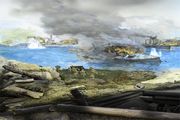
The Section of the Sea Battles of Çanakkale War Panorama
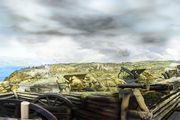
The Section of the Sea Battles of Çanakkale War Panorama

The Commander of the 19th Division Mustafa Kemal is at the Lookout Place

Depiction of Corporal Seyit who is Lifting a 215 kg Bullet.
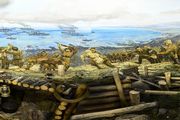
Melee Combat at Arıburnu Trenches

The Greek Army, moving into the Western Anatolia, wished to capture Ankara with a final strike.
In those days, on August 5, 1921, Mustafa Kemal was promoted to the rank of Commander-in-Chief. After a while, the army was strengthened and made ready to fight thanks to the Tekâlif-i Millîye orders that provided great help from the public. The Battle of Sakarya began with the Greek attack on August 23, 1921.
The Greeks’ objective was to weaken Turkish army on the left wing and destroy it by surrounding its southern wing. During the battle, the Greek forces managed to approach 70 kilometres to Ankara and the battles continued with the change of control over the major hills. Mustafa Kemal, uttering his following words that found a place in the world history of war, changed the fate of the battle;“The supreme objective is not to defend our lines but our land. This piece of earth stands for the whole fatherland. While a handful of the fatherland’s earth remains unsoaked with the blood of our countrymen, there shall be no retreat” It was then that the Turkish Army surpassed the Greek forces with an overwhelming success and the Greek forces hardly managed to retreat. The Battle of Sakarya took place on an area of 110 km width and 25 km depth and was the longest battle of the world which lasted 22 nights and 22 days.
The battle ended with the decisive victory of the Turkish army after a counterattack started by Turks on September 10, 1921 and the Greek army being swept to the west of Sakarya River on September 3, 1921. In the end of the battle, The Great National Assembly, as proposed by both the Commander of the West Front Ismet Pasha and Chief of General Staff Fevzi Pasha, gave Mustafa Kemal Pasha the title of Ghazi (Veteran) and the rank of Marshall on 19 September 1921 in accordance with the Resolution 153. In the panorama, the locations where the battle took place are depicted as based on the original scenery.
Following the Battle of Sakarya panorama is the spectacular portrait of Mustafa Kemal on his horse named “Sakarya”. This portrait was drawn and given to the museum as a gift by the Russian State Artist Sergey PRISEKIN.
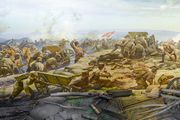
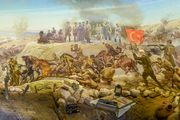

Panorama of Commander-in-Chief Battle is placed in front of Panorama of Sakarya Pitched Battle. After the Battle of Sakarya, the Turkish Army had to start an attack to sweep away the enemy troops from Anatolia. Therefore, the troops were strengthened and prepared, great number of soldiers and ammunitions were transferred to the Turkish fronts, then, an attack decision was made with the initiative of Ghazi Mustafa Kemal Pasha. According to the attack plan, the Greek troops would be surrounded beginning from southwest of Afyonkarahisar towards north, then their contact with Izmir would be intercepted. The Great Offensive began on August 26, 1922 from the Kocatepe Hill. The Battle of Commander-in-Chief was won on August 30 thanks to the outstanding combat capability of the Turkish army. On September 1, 1922 Mustafa Kemal Pasha gave the troops moving towards İzmir and chasing the enemy his historical order: “Armies, your first target is the Mediterranean. Go forward!” Throughout the Great Attack, Afyonkarahisar, Uşak and Manisa were freed from the enemy and finally İzmir was saved from the enemy on September 9, 1922. The Turkish War of Independence starting in response to the invasions at the end of the World War I was won with a decisive victory by throwing the Greek army into the sea. In this part of the panorama Mustafa Kemal Pasha is portrayed in Kocatepe in the morning of August 26. Just before him, Western Front Commander İsmet Pasha, Western Front’s Chief of Staff Colonel Asım (GÜNDÜZ) and First Army Commander Nurettin Pasha are seen. In the panorama, the fortress which was said that “if the Turks would be able to surpass this fortification in six months, they could boast asif they surpassed it in one day” that was, however, surpassed by the Turkish army in one day, is represented both in painting and 3-dimensional environment. In this part of the panorama, there is a martyr lying with the flag in hand. While Mustafa Kemal Pasha, following the victory of Battle of Commander-in-Chief, was wandering around the battlefield on August 31, 1922, he sees a martyred standard-bearer. Deeply affected by this scene, Mustafa Kemal requests that a monument be built to symbolize this . This monument, foundation of which was laid by Mustafa Kemal Pasha personally on August 30, 1924, is called “Martyr Mehmetçik Monument”. In the last part of the panorama, the strong support that the Turkish nation gave to its army and the self-sacrifice of Turkish women are portrayed.
